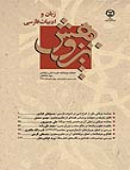تفاوت کنایه با ضربالمثل
محورهای موضوعی : پژوهشهای ادبیات کلاسیک ایران
1 - علوم انسانی
کلید واژه: ضربالمثل کنایه تعریض تفاوت کنایه و مثل استعاره,
چکیده مقاله :
کنایه و مثل دو مقوله زبانی ـ ادبی مجزا و متفاوت و با تعاریف و کارکردهای جداگانه هستند، امّا همواره بسیاری از کنایه ها در کتاب های مربوط به ضربالمثل و ذیل امثال فارسی درج و ثبت شده اند و پژوهندگان، مثل نگاران و فرهنگ نگاران، جز معدودی، در آثار خود این دو را در هم آمیخته و به تفاوتهای این دو، هیچ اشاره ای نکرده اند. این مقاله می کوشد به استناد منابع موجود، به رغم دشواری تفکیک این دو، با ملاک های مشخص و عملی تفاوتهای کنایه و مثل را نشان دهد. ابتدا پس از طرح و بحث موضوع و ذکر پیشینه تحقیق، دو حوزه کنایه و مثل را تعریف و ویژگی ها و انواع هر یک را تبیین می کنیم تا کار مقایسه شباهت و اختلاف های این دو به آسانی صورت پذیرد، سپس تفاوت ها و شباهت های کنایه و مثل را مشروح و با ذکر مثال های کافی در چندین حوزه چون ایجاز، تشبیه، استعاره، اندرزگونگی، آهنگ، جنبه تجربی، دلیل آوری، مورد و مضرب، محور جانشینی و دو وجهی بودن بررسی می کنیم. در پایان نمونه هایی از کنایات نزدیک به مثل و امثال کنایه مانند را با ملاک های عرضه شده، از هم تمایز میدهیم. تاکنون جز اشاراتی پراکنده، به طور مستقل، به موضوع این مقاله پرداخته نشده و این مقاله می تواند در حوزه های مثل شناسی و مثل نگاری در ادبیات عامه و بلاغت و بیان در ادبیات رسمی کاربرد پیدا کند.
Irony and proverb are two totally different linguistic and literary topics; with distinct definitions and functions; yet constantly many of the ironies have been mentioned in books discussing proverbs. As a matter of fact, many researchers, proverb writers and compilers of dictionaries have intermingled these two without pointing to their actual differences. This paper intends to show the differences between irony and proverb through pragmatic and concrete criteria, even though making such a distinction is indeed a hard task. Initially, after discussing this case and referring to the background of this research, the domains of irony and proverb are defined and then their features are explained. In this manner making a comparison between the two becomes easier, while afterwards the differences and similarities are elaborated. Following these discussions, irony and proverb are better conveyed through referring to other figures of speech such as brevity, tropes, rhythm, the experimental aspects, the subordination axis etc. Finally distinctions among samples of ironies similar to proverbs are clarified by the mentioned criteria. So far there has never been an independent article on this topic and therefore this paper can be practically useful within the identification of proverbs in popular literature, in addition to literary discourse and expression.

